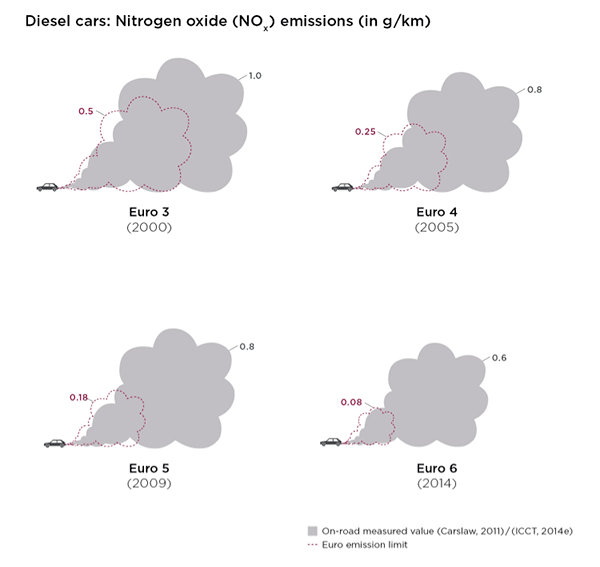Press release
[Press release] New ICCT study shows real-world exhaust emissions from modern diesel cars seven times higher than EU, US regulatory limits
On-road nitrogen oxides emission levels of modern diesel cars are on average about seven times higher than the limit set by the Euro 6 emission standard, which went into effect in September 2014. This is the key finding from a new report published today in Berlin by the International Council on Clean Transportation (ICCT), an independent research organization./p>
The study, which is the most comprehensive report on the real-world behavior of the latest generation of diesel cars published to date, found remarkable differences among individual vehicle models, indicating that technologies for real-world clean diesels already exist but are not being employed consistently by different vehicle manufacturers. The findings come at a time when the European Commission is preparing to propose an improved car emissions testing procedure, including on-road measurement, that could take effect in 2017.
The study is based on on-road tests of 15 vehicles using Portable Emissions Measurement Systems (PEMS). It covers more than 140 hours and 6,400 kilometers of driving, and provides the largest collection of public data on Euro 6 equivalent diesel cars currently available. Diesel vehicles make up about 50 per cent of all new cars in the EU. From September 2014 on, the Euro 6 standard applies to all new passenger car types.
“On average, we found that real-world nitrogen oxides emissions for modern diesel cars were about seven times higher than required by the Euro 6 standard”, says Dr. Peter Mock, Managing Director of ICCT Europe. The ICCT researchers demonstrate that the majority of exceedances found could not be attributed to extreme or untypical driving. Instead, they were due to driving situations that are part of the normal operation of diesel cars, such as mild uphill driving and regeneration events of the diesel exhaust aftertreatment system.
The ICCT experts also found significant differences among the performance of all the vehicles tested, with a few vehicles performing substantially better than the others. “This supports the notion that the technologies for real-world clean diesels already exist”, says Dr. Vicente Franco, researcher at the ICCT and lead author of the study. “Policies are needed to ensure that manufacturers will use these technologies and calibrate them to effectively control emissions over the large majority of in-use operating conditions, not just those covered by the current test cycle”.
The European Commission is currently preparing to require on-road testing as part of the passenger car type-approval process in the EU. According to these plans, vehicle manufacturers from 2017 would have to test new vehicles not only under laboratory conditions but also on the road, using PEMS equipment. Technical experts from the EU Member States will meet in Brussels on October 15 to discuss further steps and whether the new regulation can be approved at the end of 2014, as originally planned.
Nitrogen oxides emissions can have serious adverse health effects, causing major respiratory problems and leading to premature death. Diesel vehicles are the single largest contributor to total nitrogen oxide emissions in the EU. Especial in urban areas of Europe, measured nitrogen oxide emission levels are often higher than the legal limits, and some EU Member States are already facing legal actions for persistent air pollution problems.
Further information: Vicente Franco, Francisco Posada Sánchez, John German, and Peter Mock, Real-world exhaust emissions from modern diesel cars: A meta-analysis of PEMS emissions data from EU (Euro 6) and US (Tier 2 BIN 5 / ULEV II) diesel passenger cars
Download the study [PDF]. View a fact sheet [PDF].
Contact: Peter Mock, peter@theicct.org

NOx emission limits for diesel cars in the EU were lowered by 85% between 2000 (Euro 3) and 2014 (Euro 6). But over the same period on-road emission levels decreased only about 40%.
